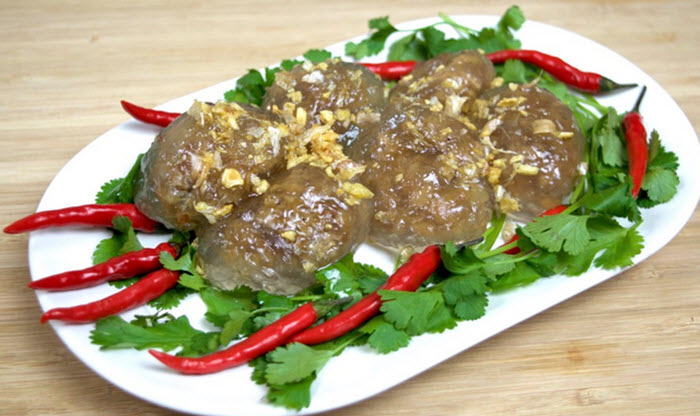5 June, 2016
Saku Sai Moo (dinner)

Saku sai moo is a popular snack sold by street vendors in Thailand, often together with some lettuce and paprika. This pork-filled dumpling was traditionally made with sago starch from tropical palm stems, but nowadays it is more common to use tapioca, a starch extracted from cassava roots. The name saku sai moo serves as a reminder of the original recipe – saku (or sakhu) is the Thai word for sago.
Ingredients list (20 dumplings)
- ½ cup small pearl tapioca
- ½ cup water
- ¼ cup peanuts (with or without skin)
- 2 cilantro sprigs
- 2 cilantro roots
- 6 Thai chili pepper fruits
- ½ cup yellow onion
- 4 cloves of garlic
- 2 tablespoons oil
- ½ cup minced pork
- 1 tablespoon fish sauce
- 1 tablespoon sugar
- ½ teaspoon ground black pepper
- 1 tablespoon of water, if necessary
- Water for steaming
- Oil for serving
Some oil and shredded banana leaves (or parchment paper) to prevent stickiness in the steamer is good to have, but not mandatory.
Instructions
Prepping the tapioca
Soak the tapioca pearls in room temperature water. The pearls are supposed to expand in size by 10-15%. You can expect this to take at least 15 minutes.
Prepping the peanuts
If you are using raw peanuts, you need to roast them. Put them in a hot frying pan (without any oil) and roast them until they are lightly brown, gently shaking the pan once in a while to prevent them from getting burned. Roasting ¼ cup of peanuts will usually take around 5 minutes.
Once the peanuts are roasted and have cooled down, it is time to ground them coarsely.
Prepping greens
- Wash cilantro sprigs, cilantro roots and chili peppers in water. Cut the chili lengthwise.
- Mince cilantro roots, garlic and onion.
Cooking the filling
- Heat up 2 tablespoons of oil in a wok over medium heat.
- Add the minced cilantro roots, garlic and onion. Fry while stirring, until the onion is translucent.
- Add the minced pork. Fry while stirring, making sure to break up the pork.
- Add the peanuts. Stir to mix everything together.
- Add fish sauce, sugar and ground pepper. Stir to mix everything together. If the filling show signs of sticking to the bottom of the wok, add a tablespoon of water.
- When the filling is brownish, it is time to taste it. It should taste both salty, sweet and spicy. Add more salt, sugar or seasoning as needed. You need a filling that is strong, since it will be wrapped in tapioca.
- Let the filling cool.
Prepping the tapioca wraps
After soaking, the tapioca balls should be soft and sticky. Knead them into a dough for 2 minutes.
Prepping the steamer
Line your steamer with shredded banana leaves, and pour some oil over the leaves. This will prevent the dumplings from sticking. If you don’t have access to banana leaves, you can use parchment paper.
Making dumplings
When the filling has cooled a bit, turn it into small and compact balls.
Each filling-ball should be less than ¾ of an inch (2 cm) in diameter. If you make it larger than that, it will be difficult to eat a dumpling without cutting it into two pieces first.
It’s now time to put the filling into tapioca wraps. Take a small amount of tapioca dough (about the same size as one of the filling-balls) and spread it out into a thin layer in your hand. Place a filling-ball on top of the dough. Place one finger on the ball to keep it in place, and gently close your hand to close the wrap around the filling-ball. Close the wrap, and move dough from thick spots to thin spots if necessary. Gently squeeze the ball to make it firmer. Check again that no filling is visible. If necessary, take a small amount of dough and use it to fix cracks and overly thin parts.
The ideal is to have a uniform wrap that covers the filling without being overly thick. A thick wrap makes the dumpling less tasty.
When you have made one dumpling, repeat until you have used up all the filling and dough. It is a good idea to have a bowl of water next to you where you can wash your hands in between each dumpling, otherwise you might encounter problems with stickiness.
Steaming dumplings
Fill the steamer with water.
Place dumplings on top of the shredded banana leaves. Don’t pack them to tightly, they need room to expand. There should be at least 1/3 of an inch (8 mm) between each dumpling.
Steam the dumplings until the wrap turns transparent. Since the meaty filling is already cooked, you don’t have to worry about it – you can focus on how the wrap looks. When the wrap is so translucent that you can see the filling and the dumplings look brownish, they are ready.
Serving dumplings
- Coat a serving plate with oil.
- Dip a spoon in oil and use it to transfer dumplings from the steamer to the serving plate.
- Garnish with cilantro sprigs and chili.
- Serve.
Tip! If you like garlic a lot, use garlic-infused oil on the serving plate. You can also sizzle some garlic oil over the dumplings.
If you want to make dumplings in advance, you can store them in the fridge for 2-3 days and then reheat them in the microwave. It is also possible to freeze dumplings and reheat in the microwave.
